Membangun Gen-Z yang Berbudaya dengan Berkain-Berkebaya di Kampus UWM Yogyakarta
(1) Widya Mataram University
(*) Corresponding Author
Abstract
The acceleration of foreign culture has indeed marginalized many people's old habits which are synonymous with the meaning of wisdom, one of which is the use of regional clothing "Kain and Kebaya" in the context of everyday life. Even though the kebaya is national clothing as stated in Presidential Decree Number 18 of 1972 concerning Types of Civil Clothing and Law Number 9 of 2010 concerning Protocols. Looking at the use of kebaya by Indonesian women today, it tends to be found only at a few formal events. As is the case with the beauty of various Indonesian fabrics which are also becoming increasingly distant from modern society. Apart from the massive onslaught of fashion trends from the international world, this continues to be another factor, especially for the younger generation. The target group for this activity is Gen-Z who are 18-25 years old and are academics at Widya Mataram University, Yogyakarta, as well as several external guests who come from the Yogyakarta area. This activity uses talk-show, question-answer and interactive simulation methods among invited guests. The contents of the activities include: (1) Indonesian fabric exhibition "Javanese Batik Art Culture, (2) fashion show (3) talk show with the title "Contemporary Culture Vs Local Culture from the Perspective of Young People", as well as "Young People's Appreciation in Building Fabric Fashion Trends Dressing", and (4) a culinary bazaar which was enlivened by a number of local MSME players. Gen-Z is invited to collaborate on social media to popularize traditional clothing. In fact, all the invited guests looked very enthusiastic and expressive following the activities by appearing using the dress code "Kebaya", "Batik", "Regional Cloth", as well as other local cultural attributes with their own colors, motifs and aesthetic values.
Keywords
Full Text:
PDFReferences
Aini, E. N., & Andjarwati, A. L. (2020). Pengaruh gaya hidup konsumtif dan kualitas produk terhadap keputusan pembelian. BISNIS: Jurnal Bisnis dan Manajemen Islam, 8 (1), 17-28.
Asosiasi Penyelenggara Jasa Internet Indonesia (APJII). 2023. Survei APJII Pengguna Internet di Indonesia Tembus 215 Juta Orang. https://apjii.or.id/berita/d/survei-apjii-pengguna-internet-di-indonesia-tembus-215-juta-orang. Diakses pada tanggal 08 Oktober 2023.
CNN Indonesia. 2019. Melestarikan Kebaya Sebagai Busana Nasional Indonesia. https://www.cnnindonesia.com/gaya-hidup/20190815170518-277-421681/melestarikan-kebaya-sebagai-busana-nasional-indonesia. Diakses pada tanggal 17 Oktober 2023
Keputusan Presiden (KEPPRES) Nomor 18 Tahun 1972 tentang Djenis-Djenis Pakaian Sipil.
Matondang, A. (2019). Dampak Modernisasi Terhadap Kehidupan Sosial Masyarakat. Wahana Inovasi: Jurnal Penelitian Dan Pengabdian Masyarakat UISU, 8(2), 188-194.
Nahak, H. M. (2019). Upaya melestarikan budaya indonesia di era globalisasi. Jurnal Sosiologi Nusantara, 5(1), 65-76.
Pramudi, R. Y. (2015). Pengaruh gaya hidup konsumtif dan kelompok referensi terhadap keputusan pembelian kosmetik lokal. Jurnal riset ekonomi dan manajemen, 15(2), 280-301.
Ramadhania, A., Geifira, G., & Santoso, G. (2023). Mengenal Lagu Daerah dan Lagu Nasional Republik Indonesia sebagai Pendidikan Multikultural bagi Mahasiswa. Jurnal Pendidikan Transformatif, 2(2), 325-335.
Saebani, B. A. (2012). Pengantar antropologi. Bandung: CV Pustaka Setia.
Sagala, H. S., & Sos, S. (2016). Memahami organisasi pendidikan: Budaya dan reinventing, organisasi pendidikan. Prenada Media.
Sekretariat Kabinet Republik Indonesia. 2023. Buka Istana Berkebaya, Presiden : Kebaya Lambangkan Karakter Masyarakat Indonesia. https://setkab.go.id/buka-istana-berkebaya-presiden-kebaya-lambangkan-karakter-masyarakat-indonesia/ Diakses pada tanggal 09 Oktober 2023.
Syakhrani, A. W., & Kamil, M. L. (2022). Budaya Dan Kebudayaan: Tinjauan Dari Berbagai Pakar, Wujud-Wujud Kebudayaan, 7 Unsur Kebudayaan Yang Bersifat Universal. Cross-border, 5(1), 782-791.
Tirto.Id. 2023. Macam-Macam Motif Batik Solo dan Makna Filosofisnya. https://tirto.id/macam-macam-motif-batik-solo-dan-makna-filosofisnya-gQC6. Diakses pada tanggal 08 Januari 2023.
Undang-Undang Republik Indonesia Nomor 9 Tahun 2010 tentang Keprotokolan.
Universitas Widya Mataram Yogyakarta. 2023. https://new.widyamataram.ac.id/. Diakses pada tanggal 10 Oktober 2023.
Article Metrics
Abstract view : 122 timesPDF - 44 times
DOI: https://doi.org/10.26714/jsm.7.2.2025.190-199
Refbacks
- There are currently no refbacks.
Copyright (c) 2025 Jurnal Surya Masyarakat

Jurnal Surya Masyarakat (JSM) is licensed under Creative Commons Attribution-NonCommercial-NoDerivatives 4.0
------------------------------------------------------------------------------------------------------------------------
Jurnal Surya Masyarakat (JSM)
p-ISSN: 2623-0364; e-ISSN: 2623-0569
Published by: Lembaga Penelitian dan Pengabdian Masyarakat (LPPM) Universitas Muhammadiyah Semarang



.jpg)







.jpg)